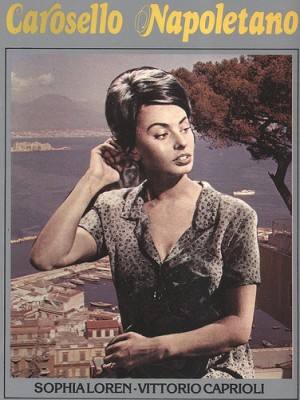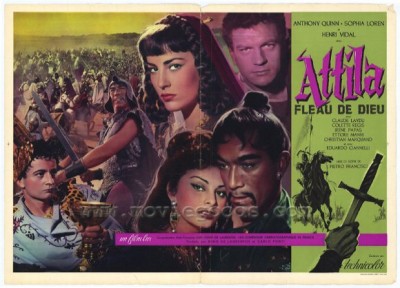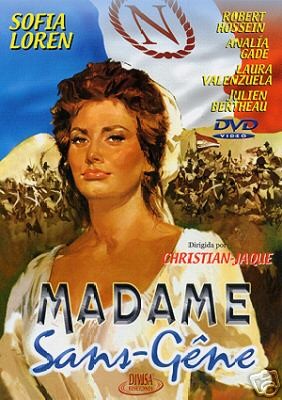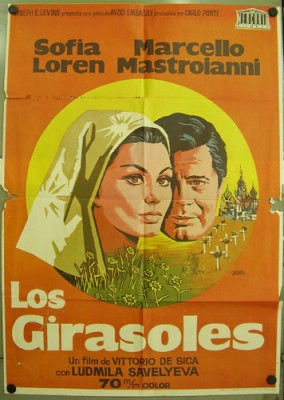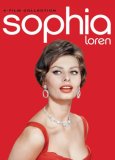| Reviews & Columns |
|
Reviews DVD TV on DVD Blu-ray 4K UHD International DVDs In Theaters Reviews by Studio Video Games Features Collector Series DVDs Easter Egg Database Interviews DVD Talk Radio Feature Articles Columns Anime Talk DVD Savant Horror DVDs The M.O.D. Squad Art House HD Talk Silent DVD
|
DVD Talk Forum |
|
|
| Resources |
|
DVD Price Search Customer Service #'s RCE Info Links |
|
Columns
|
|
|
Sophia Loren - 4-Film Collection (Carosello Napoletano / Attila / Madame Sans-Gêne / Sunflower)
Caveat Emptor Department: The packaging is rife with errors about running times (i.e., most are shorter export and/or U.S. versions), screen shapes, and available languages. Variances are noted in below in the reviews and video/audio notes.
Carosello Napoletano ("Neapolitan Carousel," 1954)
This is an almost indescribable collage of Italian music, dance, and comic interludes celebrating Naples through the centuries, in free-form vignettes structured around a hurdy-gurdy man, his poor but lively family, and the Italian standards they play. The film is bright and artificial, like something Gene Kelly and Vincente Minnelli might have whipped up on a sojourn to Europe; it reminded me a lot of Kelly's largely abstract Invitation to the Dance (filmed 1952, released 1957).
Italians, Neapolitans especially, probably love this film, which was nominated for the Grand Prize at Cannes and still managed an International Award for director Ettore Giannini. It's a visually sumptuous but fairly grueling experience. Though songs like "Funiculi, Funicula," "O Sole Mio," and "Santa Lucia" are certainly familiar, the endless references to Neapolitan folk heroes and regional quirkiness will be lost on non-Italians. Indeed, throughout the film are broad, unflattering caricatures of boorish European tourists from England, France, Sweden, etc., too stuffy to appreciate Italian earthiness. These, in turn, are outdone by the outrageous Italian stereotypes at times not far removed from Chico Marx. It's like being trapped in a '50s-style pizzeria (checkered tablecloths, garlic dangling like vines from the walls, etc.) with the fire exits blocked.
Indeed, the film is so thick with cultural references its makers presume its audience is already familiar that, quite honestly, at times I often found myself struggling to follow what was going on. The transitions from one century to the next, from reality to fantasy and back again are artistic, subtle, and confusing. In its defense, visually the film is incredibly attractive: the set design is colorful and elaborate, the blocking of actors and dancers is imaginative, and ironically the camerawork and direction are more cinematic and much less stagy than Attila (see below). It's a lovely film to look at, even if you're not sure what's going on half the time.
Sophia Loren doesn't appear until almost exactly the half-way point, in a 25-minute vignette set around 1900 where she plays an unhappy photographer's model turned cabaret singer. Like much of the all-star cast (Loren gets fourth billing) she's more like part of the scenery than a performer, but she's young and attractive and like everyone else adds to the film's high-key energy. (***)
Attila (1954)
More interesting than good, this Italian-French co-production about the brutal 5th century leader of the Hunnic Empire, the Scourge of God, plays like a proto-Peplum, a dry run for the myriad Hercules and Maciste movies that would pour out of Europe like crude oil out of the Exxon Valdez. Both Dino De Laurentiis and Sophia's much older husband, the powerful producer Carlo Ponti, had a hand in its production but most of the spectacle is limited to stationary matte paintings.
The script is almost a blueprint for a hundred peplum to follow: Attila (Anthony Quinn) and his brother, Bleda (Ettore Manni), share the Hunnic Empire throne. Bleda wants to broker peace with Roman General Aëtius (Henri Valdi) of the weakened Western Empire, but Attila wants to fight on and conquer all of Europe, with Rome as his ultimate conquest.
Meanwhile, in the court of the sadistic weakling Emperor Valentiniannus (Claude Laydu), his ambitious sister Honoria (Loren) - resentful that their mother Galla Placidia (Collete Regis) holds all the real power - proposes a marriage between herself and power-mad Attila, necessitating the murder of Attila's flesh and blood.
Attila is statically directed by Pietro Francisci, best-remembered as the director of the original Steve Reeves Hercules (1958), the film that launched the sword-and-sandal craze. Nowadays film historians give a lot of that film's credit to its inventive cinematographer, Mario Bava, rather than Francisci and the latter's work on Attila would seem to support this. Unlike the later Italian spectacles, this consists of painterly but very static standard medium shots and close-up cutaways. Filmed almost like an early Italian silent movie, there's no sweep to the film at all, though battle scenes near the end are somewhat better, and they were probably the work of a second unit director.
Looking like a Filipino transvestite, Quinn has no character to play. He's just a brute, a lifelong warrior with warrior ways who can't imagine a life of peace. Loren comes off better as the scheming sister, though both actors sound like they were dubbed by others.
Though a 100-minute running time is listed on the packaging, in fact the picture runs just 79 minutes. (The IMDb lists 83 minutes for the original U.S. release and 76 minutes for a UK video with PAL speed-up.) (** 1/2)
Madame Sans-Gêne (1962)
This generally flat but occasionally spirited film stars Loren as a kind of Gallic Eliza Doolittle: Catherine Hubscher, better known as "Madame Sans-Gêne" (literally "Mrs. No-Embarrassment") an outspoken, uneducated laundress who rises up through the ranks of the Napoleonic Court.
During the French Revolution, she meets and falls in love with a handsome sergeant, Joseph Lefebvre (Robert Hossein), who eventually becomes Marshal of France and the Duke of Dantzig. More interesting is Catherine's unpretentious, parallel friendship with Napoleon (Julien Bertheau, probably best remembered today for his multi-film association with Luis Buñuel). He's terrific, giving an amused, stoic performance to Loren's hyperactive one.
The film itself is a kind of semi-lost epic of the 1960s, and this DVD only really hints at the film's full potential. Originally a French-Italian-Spanish co-production, it was produced in Super Technirama 70 at a cost of about $6 million, making it one of the most expensive fully-European productions up to that time.
With its cast of thousands swarming the battlefields and French courts the film is quite spectacular, especially its visually stunning recreation of the Tuileries Palace (destroyed in 1871), apparently incorporating some other surviving location for its striking interiors. Unfortunately, a lot of this pageantry is lost in this DVD presentation. Though 16:9 enhanced, it plays like a second-generation general release or international version. The image is nowhere near as pristine as it should be, and once again the running time given on the packaging is incorrect.
Both the Italian DVD and Lionsgate's box text list 118 minutes, but like Attila the movie is shorn of 20 minutes, running a rather schizophrenic 98 minutes instead. (Moreover, the packaging states the film as being "in Italian/French" though really it's entirely in French with some short snippets of dialogue involving the Austrian army that are in German.) As a result, the nearly 20-year span the film covers feels awfully abridged at times.
The film begs the obvious question: Why didn't the filmmakers cast someone actually French to play this symbol of unpretentious French citizenry - say for instance, Jeanne Moreau? Nonetheless, Loren comes off surprisingly well, even speaking French throughout the film (without it negatively affecting her performance), though her voice sounds like it was dubbed. Though personally I find her dipped-in-bronze look of later years singularly unattractive, here she's just about at the zenith of her playful sexiness; in the opening scenes, the sweaty laundress's braless breasts are in constant danger of falling out of her dress. (***)
Sunflower (I Girasoli, or "The Sunflowers," 1970)
Though schmaltzy and predictable, this handsomely directed Vittorio De Sica film has some fine acting and incredible footage shot in the Soviet Union. A telling scene early in the film depicts nothing more than Sophia Loren and Marcello Mastroianni, playing wartime newlyweds, making a 24-egg omelet. Nothing much happens beyond "Pass the salt" yet the two have such chemistry and star power even something as innocuous as watching two people cooking and eating becomes pretty engrossing.
The story is like Kinji Fukasaku's angry Under the Fluttering Military Flag done in the style of a lush Harlequin romance. Neapolitan peasant woman Giovanna (Loren) falls in love with 32-year-old (Ha!) Milanian soldier Antonio (45-year-old Mastroianni), whom she likes to call "Anto." After he unsuccessfully tries for the Italian equivalent of a Section Eight discharge he's shipped off to the Russian front where he promptly goes missing, and the film mainly traces her efforts to find him.
The picture is billed as an Italian-French co-production, but all the scenes filmed on location in the Soviet Union were with the cooperation of Mosfilm, and the U.S. version titles (included on this release, even though the feature is uncut and presented in Italian) credit Embassy's Joseph E. Levine as executive producer. That credit may be deliberating misleading and refer only to the U.S. release version, but then again maybe Levine helped secure the services of composer Henri Mancini, whose lovely score (reminiscent in some ways of Two for the Road) adds considerably to the film's lushness.
The film's main strengths are its amazing footage shot inside the Soviet Union, especially around contemporary Moscow. There are, of course, a number of Soviet-made films available now on DVD but this outsider's vantage point makes it exceptionally interesting. (Supposedly this was the first non-Communist Bloc production allowed to shoot there.)
Loren is also good, giving by far her most complete performance of the set, and arguably her best. For one thing, audiences get to hear the real Loren; quite unusual for an Italian production of the period, live sound was recorded throughout and it's clearly her voice. For another, Loren is in her métier, playing the Neapolitan peasant woman she really was, husband Carlo Ponti's glamorization of his wife notwithstanding. And of course, Mastroianni, as he almost always was, is eminently watchable, if really too old for the part. (***)
Video & Audio
Carosello Napoletano is listed on the packaging as a 129-minute film in 16:9 widescreen but in fact runs 124 minutes and is 4:3 full frame, reflecting its original 1.37:1 theatrical aspect ratio. The film has rich if unnatural color and is in good shape. No color process or laboratory is credited on the Italian version, but appears to have been shot in Pathécolor (France) and printed by Technicolor Rome.
Attila, also full frame, has much harsher color and even reel change cues, suggesting this may be derived from a theatrical print. Madame Sans-Gêne, though 16:9 widescreen is barely okay when it should look (and sound) spectacular. The source material is similarly harsh and worn; the fact that a Super Technirama credit is missing from the titles (no process is credited onscreen, though Eastman Color is credited, a dead giveaway) offers further evidence that was a cheap general release and/or international version. Adding to the confusion, a shadowy frame-type line running across the top of the image is visible through much the film; this may be a defect in the horizontal negative to 35mm 'scope transferring process. Presumably this had fully directional multi-track audio in France and Italy, but is ordinary mono here.
Similarly, Sunflower was a 70mm blow-up in Europe (see the poster above) but a flat 1.66:1 release in the U.S. (16:9 enhanced on DVD.) Though the DVD uses the U.S. release titles (noting Technicolor with prints by Movielab) the film runs 107 minutes, six minutes longer this time than what's printed on the box, and an English-dubbed track is not available. The source material is grainy and may be a theatrical print; like the other films in this collection, reel change cues are highly visible. The color timing seems off; in one scene Allied bombers drop flares to see a bridge they're trying to bomb, but the footage looks like late afternoon. The opening titles are 1.66:1 but the rest of the film is 1.78:1. All four films include optional English and Spanish subtitles.
Extra Features
The only extra is a pretty good 16:9 enhanced widescreen, 18-minute featurette, Sophia Loren: La Diva Popolana. It features interviews with various film and Italian culture scholars and two of Loren and Carlo Ponti's sons. It also discusses each film in some detail, though a long discussion about Italian Neorealism seems out of place considering none of the films are. Curiously, clips of the two older films are presented here in 16:9 widescreen, though they seem derived from the same film source.
Parting Thoughts
All told, this is a pretty strange packaging of disconnected and very different movies, but for the more adventurous that's also part of the appeal. The films here are interesting but flawed, and none are among Loren's best, but it's fascinating material in its own way, and I hope this sells well enough to encourage Lionsgate to release more like it.
Film historian Stuart Galbraith IV's latest book, The Toho Studios Story, is on sale now.
|
| Popular Reviews |
| Sponsored Links |
|
|
| Sponsored Links |
|
|
| Release List | Reviews | Shop | Newsletter | Forum | DVD Giveaways | Blu-Ray | Advertise |
|
Copyright 2024 DVDTalk.com All Rights Reserved. Legal Info, Privacy Policy, Terms of Use,
Manage Preferences,
Your Privacy Choices | |||||||









